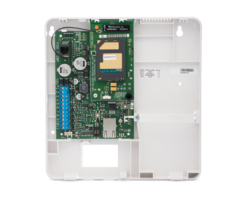Welcome DIYers! We're here with another video recap, this time covering June 10th thru 14th. It was a great week for our video team, as 10 new videos are ready for viewing. Your favorite Alarm Grid boys Jarrett, Joe and Jorge are all here. Let's check out the newest videos from the team.
Location of the MAC Address on a Honeywell L5210
Jarrett teaches users how to find the MAC address for your Honeywell L5210 Security System. The MAC address is actually associated with the added Honeywell L5100-WIFI Card. You will need to provide this code when activating your WIFI communicator for monitoring service. The code consists of a 12 digit combination of numbers and letters. This code can be found on the box for the L5100-WIFI, on the module itself or inside panel programming. You will also need to provide the CRC code, which is found alongside the MAC address.
Panels That Support Telguard HomeControl Flex
The helpful and friendly Joe talks about which panels support the Telguard HomeControl Flex interactive service. This service is a lot like Total Connect 2.0 and Alarm.com. In order to access this service, you will need an appropriate Telguard Communicator. You will also need active alarm monitoring service. Most Alarm Grid customers access this service using a Telguard TG1-Express. This communicator allows a panel with a phone line to communicate across a cellular network.
Resideo Total Connect 2.0 Recording Limits
Jorge discusses the Resideo Total Connect 2.0 recording limits for Resideo IP Cameras. The limit depends on which type of Resideo IP Cameras you are using with your system. The newer HD camera models allow you to store up to 1,500 clips for up to 30 days. Any clip older than 30 days will be automatically deleted. Additionally, clips are deleted if you reach the 1,500 clip limit. The older, non-HD models allow for 100MB of storage or 7 day, whichever comes first.
SkyBell Video Clip Availability
Jorge explains the SkyBell video clip availability limits for both Total Connect 2.0 and Alarm.com. These services follow completely different rules in this regard. For Total Connect 2.0, clips are stored for seven (7) days. For Alarm.com, it is more complicated. It depends on what type of monitoring plan you have. There will be a limit to the number of total clips you can store on Alarm.com. There will also be a limit on the number of clips your cameras can store per month on Alarm.com.
Learning the Honeywell 5800CO into a Qolsys IQ Panel 2 Plus
The ever-cheeky Joe teaches you how to add a Honeywell 5800CO Carbon Monoxide Sensor into a Qolsys IQ Panel 2 Plus System. You must use the 345 MHz version of the IQ Panel 2 Plus if you want to add a Honeywell 5800CO Sensor. This is the only version of the IQ Panel 2 Plus that can support 345 MHz sensors. This module will provide your home or business with accurate and reliable detection of potentially lethal carbon monoxide gas.
Flood Sensor Notifications from a Lyric via Apple HomeKit
Jarrett is back, and he explains why you cannot receive flood sensor notifications from Apple HomeKit when the sensor is used with a Lyric Controller. HomeKit only provides detailed Lyric notifications regarding security sensors. A flood sensor is not a security sensor. That is why it is important to still use Total Connect 2.0 even if you start using Apple HomeKit with the system. The Total Connect 2.0 platform will provide you with specific notifications for any zone type.
Learning the 5808W3 into a Qolsys IQ Panel 2 Plus
Jorge teaches users how to add a 5808W3 Smoke and Heat Detector with a Qolsys IQ Panel 2 Plus Security System. This smoke detector can only be added to IQ Panel 2 Plus Systems that support the 345 MHz wireless frequency. The 5808W3 provides reliable smoke and heat detection for a home or business. It can also be used for low temperature detection. A built-in 85 dB sounder is integrated with the sensor for alerting building occupants.
Products Supported on the Alarm.com Platform
Jorge explains which products are supported by the Alarm.com interactive service. To use Alarm.com, you will need a system with an Alarm.com Cellular Communicator. You will also need a Gold Plan or higher from Alarm Grid. By accessing Alarm.com, you can arm and disarm your system, check current system status, control smart home devices and more. You can access this service remotely using the Alarm.com Mobile App on Android and iOS devices.
Image Sensor and Alarm Panel Compatibility
Awesome Joe covers image sensor and alarm panel compatibility. Image sensors are like motion detecting sensors, except they also have a built-in camera. When an image sensor detects movement, it will produce a photo. This photo can be sent to an interactive service platform like Total Connect 2.0 or Alarm.com. If you have the TC2 or ADC mobile app, you can get this image remotely. This is perfect for verifying if a crime or emergency is occurring in your home or business.









